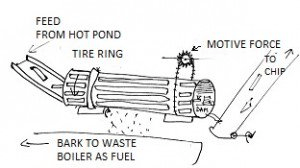This set of Pulp and Paper Multiple Choice Questions and Answers (MCQs) focuses on “Wood Chips Preparation and Handling at the Pulp Mill”.
1. What is the purpose of barker?
a) Remove bark from wood after chipping
b) Remove bark from wood before chipping
c) Add a bark like layer before chipping
d) Add a bark like layer after chipping
View Answer
Explanation: bark is not useful as it has negligible fiber. It darkens pulp, requires extra chemical usage and introduces contaminations. Hence bark is removed from wood before chipping.
2. What type of barker is this?

a) Drum
b) Hydraulic
c) Rosewood
d) Aviato
View Answer
Explanation: large rotating steel drum mounted with exit lower than the entrance to promote flow of logs.
3. A dam controls log retention time in drum barker.
a) True
b) False
View Answer
Explanation: A dam at exit controls the log retention time, which is of the order of 20 – 30 minutes.
4. Which type of barker is ideal for small mills.
a) Hydraulic
b) Drum
c) Rosserhead
d) Aviato
View Answer
Explanation: In this logs are fed individually. It is a slow process suitable for frozen logs.
5. Waste water from hydraulic barker is higher in ______________
a) LRP
b) CRP
c) NPR
d) BOD
Explanation: It is a type of pollutant which needs to the treated before discharging.
6. Which are the two types of barkers in the following?
a) Flat
b) Slasher deck
c) Flail
d) Cylinder
View Answer
Explanation: Uses a rotating cylinder with numerous chains hanging from it to delimb and debark small diameter material.
7. Is Softwood easier to chip and generate fewer fine chips?
a) True
b) False
View Answer
Explanation: It is because Hardwood is in a more dry and hard form than Softwood.
8. Arrange this in proper downward order
a) Oversized – Over thick – Accepts – Pins – Fines
b) Oversized – Over thick – Pins – Accepts – Fines
c) Over thick – Oversized – Accepts – Pins – Fines
d) Fines – Over thick – Accepts – Pins – Oversized
View Answer
Explanation: This is ideal chip size distribution analysis for perfect functioning.
9. _____________ are the chip fraction of the ideal size distribution analysis perfect for pulping.
a) Pins
b) Accepts
c) Rejects
d) Fines
View Answer
Explanation: These chips pass through a 8 or 10mm slotted screen and are retained on a screen with holes.
10. At the bottom of the pass __________ are collected?
a) Fines
b) Pin
c) Accepts
d) Silth
View Answer
Explanation: The definition of fines varies with mill species, but fines generally consist of material passing through 3mm screen
Sanfoundry Global Education & Learning Series – Pulp and Paper.
To practice all areas of Pulp and Paper, here is complete set of 1000+ Multiple Choice Questions and Answers.
If you find a mistake in question / option / answer, kindly take a screenshot and email to [email protected]
- Apply for Chemical Engineering Internship
- Check Chemical Engineering Books
- Practice Chemical Engineering MCQs
